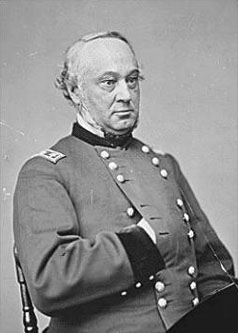| Henry W. Halleck  AKA Henry Wager Halleck AKA Henry Wager Halleck
Born: 16-Jan-1815
Birthplace: Westernville, NY
Died: 9-Jan-1872
Location of death: Louisville, KY
Cause of death: unspecified
Remains: Buried, Green-Wood Cemetery, Brooklyn, NY
Gender: Male
Race or Ethnicity: White
Occupation: Military Nationality: United States
Executive summary: Commander of US Army, 1862-64 Military service: Union Army American general and jurist, born at Westernville, Oneida county, New York in 1815, entered the West Point military academy at the age of twenty, and on graduating in 1839 was appointed to the engineers, becoming at the same time assistant professor of engineering at the academy. In the following year he was made an assistant to the Board of Engineers at Washington, from 1841 to 1846 he was employed on the defense works at New York, and in 1845 be was sent by the government to visit the principal military establishments of Europe. After his return, Halleck delivered a course of lectures on the science of war, published in 1846 under the title Elements of Military Art and Science. A later edition of this work was widely used as a textbook by volunteer officers during the Civil War. On the outbreak of the Mexican War in 1846, he served with the expedition to California and the Pacific coast, in which he distinguished himself not only as an engineer, but by his skill in civil administration and by his good conduct before the enemy. He served for several years in California as a staff officer, and as secretary of state under the military government, and in 1849 he helped to frame the state constitution of California, on its being admitted into the Union. In 1852 he was appointed inspector and engineer of lighthouses, and in 1853 was employed in the fortification of the Pacific coast. In 1854 Captain Halleck resigned his commission and took up the practice of law with great success. He was also director of a quicksilver mine, and in 1855 he became president of the Pacific & Atlantic railway. On the outbreak of the Civil War he returned to the army as a major-general, and in November 1861 he was charged with the supreme command in the western theater of war. There can be no question that his administrative skill was mainly instrumental in bringing order out of chaos in the hurried formation of large volunteer armies in 1861, but the strategic and tactical successes of the following spring were due rather to the skill and activity of his subordinate generals Grant, Buell and Pope, than to the plans of the supreme commander, and when he assumed command of the united forces of these three generals before Corinth, the methodical slowness of his advance aroused much criticism. In July, however, he was called to Washington as general-in-chief of the armies. At headquarters his administrative powers were conspicuous but he proved to be utterly wanting in any large grasp of the military problem; the successive reverses of Generals McClellan, Pope, Burnside and Hooker in Virginia were not infrequently traceable to the defects of the general-in-chief. No coordination of the military efforts of the Union was seriously undertaken by Halleck, and eventually in March 1864 Grant was appointed to replace him, Major-General Halleck becoming chief of staff at Washington. This post he occupied with credit until the end of the war. In April 1865 he held the command of the military division of the James and in August of the same year of the military division of the Pacific, which he retained until June 1869, when he was transferred to that of the South, a position he held until his death at Louisville, Kentucky, on the 9th of January 1872. Halleck's position as a soldier is easily defined by his uniform success as an administrative official, his equally uniform want of success as an officer at the head of large armies in the field, and the popularity of his theoretical writings on war. His influence, for good or evil, on the course of the Civil War was greater than that of any soldier on either side save Grant and Lee, and while his interference with the dispositions of the commanders in the field was often disastrous, his services in organizing and instructing the Union forces were always of the highest value, and in this respect he was indispensable.
Besides Military Art and Science, Halleck wrote Bitumen, its Varieties, Properties and Uses (1841); The Mining Laws of Spain and Mexico (1859); International Law (1861; new edition, 1908); and Treatise on International Law and the Laws of War, prepared for the use of Schools and Colleges, abridged from the larger work. He translated Jomini's Vie politique et militaire de Napoléon (1864) and de Fooz On the Law of Mines (1860). The works on international law mentioned above entitle General Halleck to be considered as one of the great jurists of the 19th century.
High School: Hudson Academy
University: Union College
University: US Military Academy, West Point (1839)
Professor: US Military Academy, West Point
Funeral: Abraham Lincoln (1865) Pall bearer
Requires Flash 7+ and Javascript.
Do you know something we don't?
Submit a correction or make a comment about this profile
Copyright ©2019 Soylent Communications
|